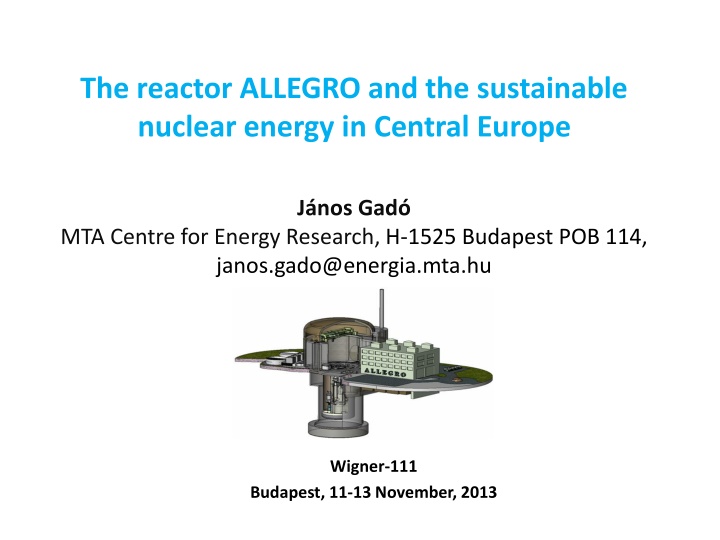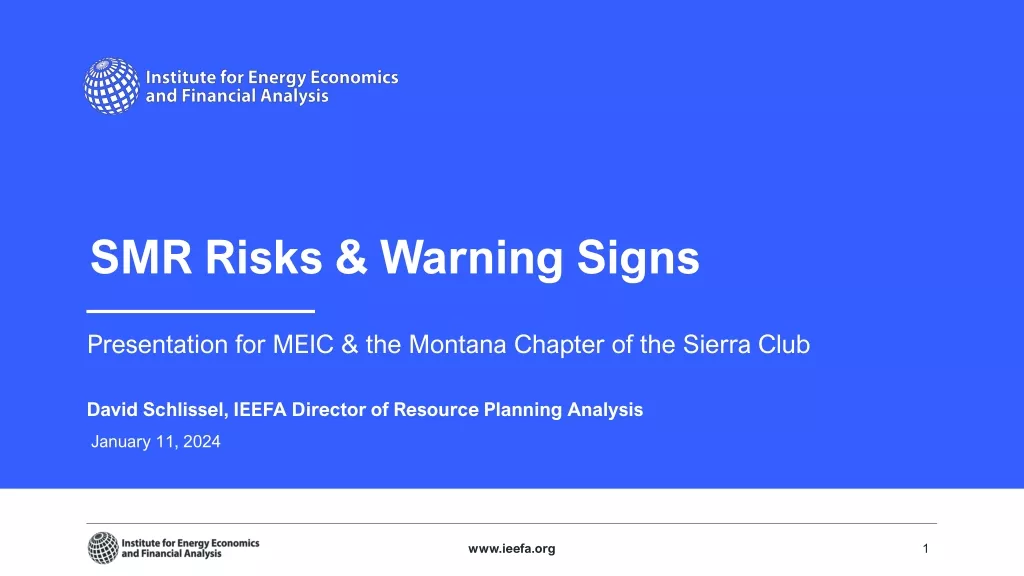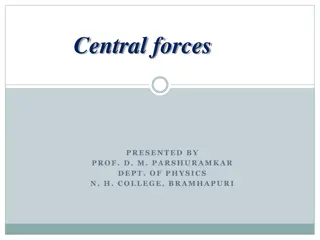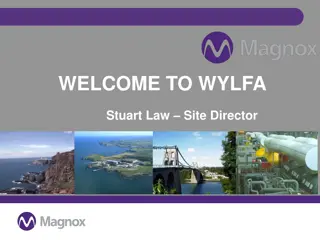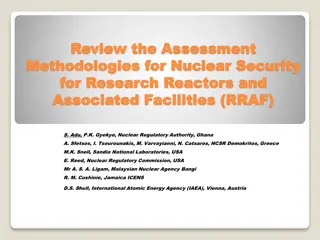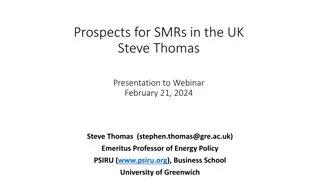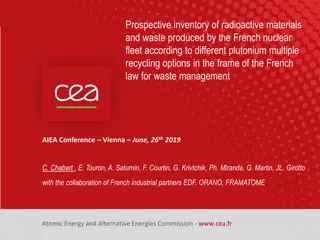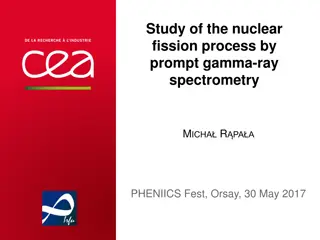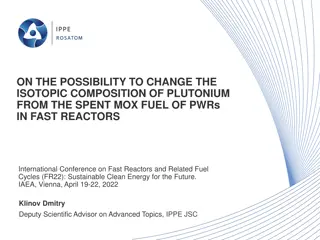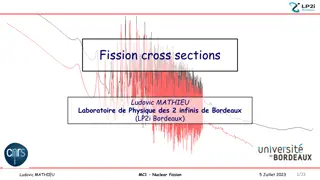Advancing Sustainable Nuclear Energy in Central Europe with Fast Reactors
Explore the potential of G4 fast reactors for advancing sustainable nuclear energy in Central Europe. Learn how fast neutron spectrum reactors can help address uranium stock depletion, waste elimination, and fuel cycle closure. Discover the regional long-term solution proposed for V4 countries and the development of Gas Cooled Fast Reactors (GFR) with innovative coolant materials like Sodium, Helium, and Lead/Bismuth.
Download Presentation

Please find below an Image/Link to download the presentation.
The content on the website is provided AS IS for your information and personal use only. It may not be sold, licensed, or shared on other websites without obtaining consent from the author.If you encounter any issues during the download, it is possible that the publisher has removed the file from their server.
You are allowed to download the files provided on this website for personal or commercial use, subject to the condition that they are used lawfully. All files are the property of their respective owners.
The content on the website is provided AS IS for your information and personal use only. It may not be sold, licensed, or shared on other websites without obtaining consent from the author.
E N D
Presentation Transcript
The reactor ALLEGRO and the sustainable nuclear energy in Central Europe J nos Gad MTA Centre for Energy Research, H-1525 Budapest POB 114, janos.gado@energia.mta.hu Wigner-111 Budapest, 11-13 November, 2013
Why G4 fast reactors? The nuclear reactors (of thermal neutron spectrum) which are constructed nowadays are mature: they have reached a very high safety level. Nuclear reactor fleets can satisfy the demand of secure electricity supply without carbon emission. Two problems are however undeniable: the uranium stocks are finite and may be exhausted within 100 years, the spent fuel and high level waste should be eliminated at a reasonable time scale. Nuclear reactors with fast neutron spectrum can solve these problems, therefore nuclear R&D should be concentrated on their development. The fast neutron spectrum is needed for solving the above problems.
Closing the fuel cycle - 1 Fast reactors can produce as much fissionable material (plutonium) as they consume. This makes their use sustainable.
Closing the fuel cycle - 2 The radiotoxicity of spent fuel and HLW can be largely reduced by using a fleet of thermal and fast reactors and a proliferation-safe advanced reprocessing.
A long term regional solution for V4 The Visegr d-4 (V4) countries (CZ, HU, PL, SK) intend to use nuclear energy on the long run. They will construct new Generation 3+units in the next decades. Nuclear units with about 20 GWewill be operated in G4 in the second half of the 21stcentury. If the V4 countries will continue the use of nuclear energy in the 22ndcentury, they can build up a regional solution with a joint reprocessing plant and a joint fuel fabrication plant and by combining thermal and fast reactors in the countries. In order to move into this direction the spent fuel of the Gen 3+ units should be reprocessed to have the plutonium stock necessary for fuelling fast reactors in the first years of their operation.
Potential reactor coolant materials Fast neutron spectrum can be maintained by excluding light elements as coolant materials. The potential coolants are Sodium Helium and Lead or lead/bismuth. Each coolant has advantages and drawbacks. The most experience is collected for sodium. EU is dealing with all the three potential solutions. V4 R&D institutes were invited by CEA (F) to take the lead in Gas Cooled Fast Reactor development. GFR can have good burning/breeding properties, moreover it can provide high temperature (850 C) gas for industrial applications. GFR has to have an appropriate fuel which is still under discussion. The GFR technology and the applicability of the perspective fuel shall be demonstrated in the new reactor ALLEGRO to be built in one of the V4 countries.
ALLEGRO the reactor - ALLEGRO will be the demonstrator reactor of the Gas Cooled Fast Reactor (GFR) - ALLEGRO power will be 75 MWth, with no electricity production - The aim is to put the reactor into operation in the second part of the next decade The existing safety concerns have to be removed on the basis of appropriate experiments and by design modifications
ALLEGRO design The main safety related challenge of the current ALLEGRO design is the low thermal inertia of coolant and fuel and the high power density in the core. Therefore the basic design of CEA has been modified several times in the last years. The technology has to be tested experimentally, partly by using problem oriented loops and other devices, partly on an electrically heated dedicated mock-up.
ALLEGRO fuel ALLEGRO will start with MOX fuel in SS cladding, allowing for testing the innovative GFR ceramic fuel assemblies in dedicated irradiation channels of high temperature (850 C). Design of the first MOX fuel is under discussion since the original French design (based on Ph nix fuel rods) is not practicable. The actual concept is still the use of fuel similar to ASTRID fuel (ASTRID is the sodium cooled fast reactor prototype). Applicability of this fuel in ALLEGRO conditions has to be justified by a qualification process. Low thermal inertia of the coolant is an unavoidable feature of gas cooled reactors. The gas cooled thermal reactors use graphite coated fuel making use of the advantageous thermal properties of graphite. Though graphite cannot be used for fast reactor purposes, the use of an alternative fuel instead of ASTRID-type fuel already in the first phase of ALLEGRO is under investigation.
ALLEGRO project organization The Preparatory phase of the ALLEGRO project was launched by the Czech, Hungarian and Slovak nuclear R&D organizations in 2010 with a strong participation of CEA, provider of the original design. NCBJ Poland joined in 2012. The Preparatory phase of the ALLEGRO project aims at the preparation of documentation for decision makers deciding on ALLEGRO site and on the start of ALLEGRO licensing and construction: safety concept, pre-conceptual and conceptual design, safety analyses, licensing documents proposing a site in CZ, HU or SK for the reactor to be decided by the governments of the region. In the next period a great attention will be paid to experimental justification of safety and fuel and system qualification. In order to organize these activities the V4G4 Centre of Excellence was established in 2013.
The V4G4 Center of Excellence GFR Technology Research Laboratory (Helium technology) JV e , CZ Design & Safety Concept Research Laboratory VUJE Trnava, SK V4G4 Centre of Excellence for Research GFR Fuel and Reprocessing Research Laboratory MTA EK Budapest, HU GFR Material Research Laboratory (except fuel) NCBJ wierk, PL CEA scientific support
